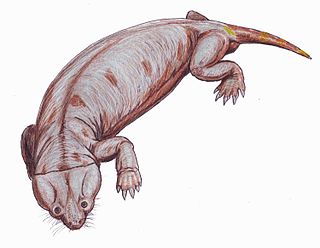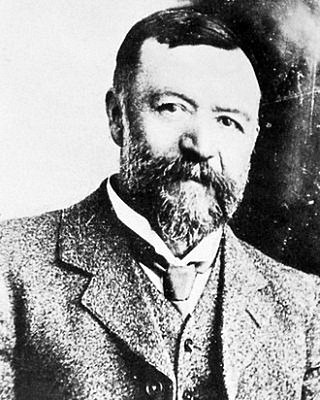
Cynognathus is an extinct genus of large-bodied cynodontian therapsids that lived in the Middle Triassic. It is known from a single species, Cynognathus crateronotus. Cynognathus was a predator closely related to mammals and had a southern hemispheric distribution. Fossils have so far been recovered from South Africa, Argentina, Antarctica, and Namibia.

Harry Govier Seeley was a British paleontologist.

Euskelosaurus is a sauropodomorph dinosaur from the Late Triassic of South Africa and Lesotho. Fossils have only been recovered from the lower Elliot Formation in South Africa and Lesotho, and in one locality in Zimbabwe.

Cumnoria is a genus of herbivorous iguanodontian dinosaur. It was a basal iguanodontian that lived during the Late Jurassic period in what is now Oxfordshire, United Kingdom.

Hortalotarsus is a dubious genus of extinct sauropodomorph from the Early Jurassic (Sinemurian-aged) Clarens Formation of Eagle's Crag, South Africa.

Ornithopsis is a genus of sauropod dinosaur, from the Early Cretaceous of England and possibly Germany. The type species, which is the only species seen as valid today, is O. hulkei, which is only known from fragmentary remains.

Macrurosaurus is the name given to a genus of dinosaur from the Early Cretaceous. It was a titanosauriform which lived in what is now England. The type species, M. semnus, was named in 1876. A second species, M. platypus, may also exist.

Saurischia is one of the two basic divisions of dinosaurs, classified by their hip structure. Saurischia and Ornithischia were originally called orders by Harry Seeley in 1888 though today most paleontologists classify Saurischia as an unranked clade rather than an order.

The Cistecephalus Assemblage Zone is a tetrapod assemblage zone or biozone found in the Adelaide Subgroup of the Beaufort Group, a majorly fossiliferous and geologically important geological group of the Karoo Supergroup in South Africa. This biozone has outcrops located in the Teekloof Formation north-west of Beaufort West in the Western Cape, in the upper Middleton and lower Balfour Formations respectively from Colesberg of the Northern Cape to east of Graaff-Reinet in the Eastern Cape. The Cistecephalus Assemblage Zone is one of eight biozones found in the Beaufort Group, and is considered to be Late Permian in age.

The Daptocephalus Assemblage Zone is a tetrapod assemblage zone or biozone found in the Adelaide Subgroup of the Beaufort Group, a majorly fossiliferous and geologically important Group of the Karoo Supergroup in South Africa. This biozone has outcrops located in the upper Teekloof Formation west of 24°E, the majority of the Balfour Formation east of 24°E, and the Normandien Formation in the north. It has numerous localities which are spread out from Colesberg in the Northern Cape, Graaff-Reniet to Mthatha in the Eastern Cape, and from Bloemfontein to Harrismith in the Free State. The Daptocephalus Assemblage Zone is one of eight biozones found in the Beaufort Group and is considered Late Permian (Lopingian) in age. Its contact with the overlying Lystrosaurus Assemblage Zone marks the Permian-Triassic boundary.

The Cynognathus Assemblage Zone is a tetrapod biozone utilized in the Karoo Basin of South Africa. It is equivalent to the Burgersdorp Formation, the youngest lithostratigraphic formation in the Beaufort Group, which is part of the fossiliferous and geologically important Karoo Supergroup. The Cynognathus Assemblage Zone is the youngest of the eight biozones found in the Beaufort Group, and is considered to be late Early Triassic (Olenekian) to early Middle Triassic (Anisian) in age. The name of the biozone refers to Cynognathus crateronotus, a large and carnivorous cynodont therapsid which occurs throughout the entire biozone.

The Pristerognathus Assemblage Zone is a tetrapod assemblage zone or biozone which correlates to the upper Abrahamskraal Formation and lowermost Teekloof Formation, Adelaide Subgroup of the Beaufort Group, a fossiliferous and geologically important geological Group of the Karoo Supergroup in South Africa. The thickest outcrops, reaching not more than 300 metres (980 ft), occur just east of Sutherland through to Beaufort West in the south and Victoria West in the north. Exposures are also found west of Colesberg and south of Graaff-Reinet. The Pristerognathus Assemblage Zone is the third biozone of the Beaufort Group.

The Tropidostoma Assemblage Zone is a tetrapod assemblage zone or biozone which correlates to the lower Teekloof Formation, Adelaide Subgroup of the Beaufort Group, a fossiliferous and geologically important geological Group of the Karoo Supergroup in South Africa. The thickest outcrops, reaching approximately 240 metres (790 ft), occur from east of Sutherland through to Beaufort West and Victoria West, to areas south of Graaff-Reinet. Its northernmost exposures occur west/north-west of Colesberg. The Tropidostoma Assemblage Zone is the fourth biozone of the Beaufort Group.

Procolophon is a genus of lizard-like procolophonid parareptiles that first appeared in the Early Triassic (Induan) of South Africa, Brazil, and Antarctica. It persisted through the Permian–Triassic extinction event, but went extinct in the beginning of the Early Middle Triassic. The type species is P. trigoniceps.

Eunotosaurus is an extinct genus of amniote, possibly a close relative of turtles. Eunotosaurus lived in the late Middle Permian and fossils can be found in the Karoo Supergroup of South Africa and Malawi. Eunotosaurus resided in the swamps of what is now southern Africa. Its ribs were wide and flat, forming broad plates similar to a primitive turtle shell, and the vertebrae were nearly identical to those of some turtles. Accordingly, it is often considered as a possible transitional fossil between turtles and their prehistoric ancestors. However, it is possible that these turtle-like features evolved independently of the same features in turtles, since other anatomical studies and phylogenetic analyses suggest that Eunotosaurus may instead have been a parareptile, an early-diverging neodiapsid unrelated to turtles, or a synapsid.

Tropidostoma is a medium-sized herbivorous oudenodontid dicynodont therapsid that lived during the Late Permian (Lopingian) period in South Africa. The first Tropidostoma fossil was described by Harry Govier Seeley in 1889. Later two subspecies were identified. Tropidostoma fossils are an index fossil in a biozone of the Karoo Basin known as the Tropidostoma Assemblage Zone. This biozone is characterized by the presence of this species in association with another dicynodont species, Endothiodon uniseries.

Diademodon is an extinct genus of cynodonts. It was about 2 metres (6.6 ft) long.

Diademodontidae is an extinct family of Triassic gomphodonts. The best-known genus is Diademodon from South Africa. Titanogomphodon from Namibia may also be a member of Diademodontidae. The Chinese genera Hazhenia and Ordosiodon have also been included in the family, but were more recently identified as baurioid therocephalians. Remains of a diademodontid were reported in the Early-Middle Triassic Fremouw Formation in Antarctica, but that specimen was later referred to the trirachodontid Impidens.

Alice, Lady Harris was an English missionary and an early documentary photographer. Her photography helped to expose the human rights abuses in the Congo Free State under the regime of King Leopold II of the Belgians.

Daniel Rossouw Kannemeyer was a South African medical practitioner, naturalist, archaeologist and palaeontologist, the son of Daniel Gerhardus Kannemeyer and Johanna Susanna Rossouw He is best remembered for his contributions to palaeontology and archaeology although his collections of zoological specimens are greatly valued by the museums which acquired them.





















